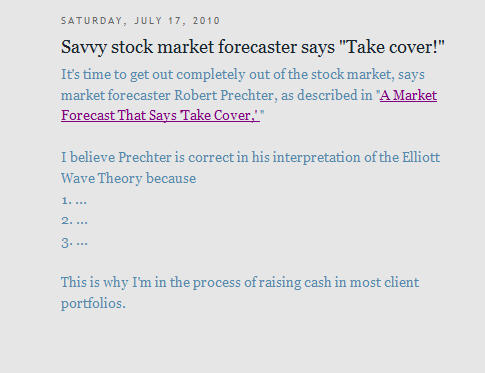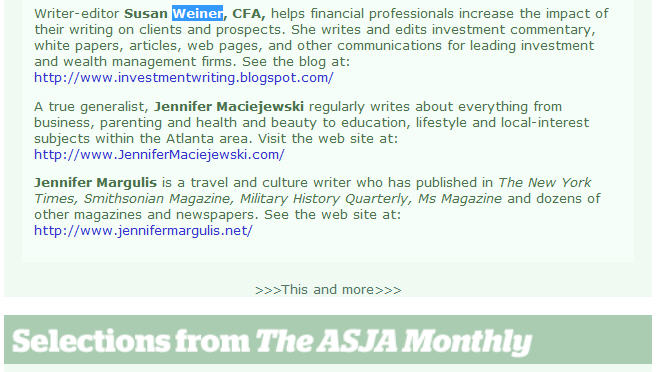SeekingAlpha.com looks like a great way for investment professionals to share their opinions and market themselves. So when I met Geoff Considine and learned he’d done exactly that, I asked him to guest-blog about his experience.
How Seeking Alpha Can Build Your Professional Reputation
by Geoff Considine
Writing for SeekingAlpha.com has helped me develop my professional reputation and gain attention for my quantitative modeling  software and consulting services. Financial professionals can build a substantial brand from SeekingAlpha. Quite a few writers, advisors, consultants, and others have developed enormous reach on the basis of SeekingAlpha. I am certainly not even among the most successful.
software and consulting services. Financial professionals can build a substantial brand from SeekingAlpha. Quite a few writers, advisors, consultants, and others have developed enormous reach on the basis of SeekingAlpha. I am certainly not even among the most successful.
If I can do it, so can you, especially if you follow the six rules I give at the end of this article.
My experience publishing on SeekingAlpha.com
I have been writing for SeekingAlpha.com since January 2006. At that time, I had fairly recently launched a software tool for financial advisors and individual investors and I was trying to drum up some attention. All in, I have written 127 articles on SeekingAlpha.com, even though I have not written for them since September 2009. I have written a lot over the last year, but I have developed a sufficiently deep audience that I have only been writing for advisor-focused publications such as Advisor Perspectives. I am quite confident that I never would have been able to write for these professional publications without the experience and reputation gained from writing for SeekingAlpha.com.
Quantext, my small company, gets about 100,000 hits a month on its website in a good month. I sell software and e-books, along with doing consulting on analytical models for portfolio management and asset allocation. The only marketing that I have ever done for my business is writing—and SeekingAlpha.com was the only place that I published articles (aside from my own website) in the first couple of years of building out the software side of my business.
Once something is published on a site like SA, people will go back and look at what you have said in the past—it’s a fairly permanent record. This can be great when your thinking is validated, but can pose reputational risk if you make some outlandish statement. Back in 2007, for example, one of The Motley Fool’s best-known columnists came out and said that he risk measures such as Beta and volatility just didn’t matter at all, not matter what all the academics say. His timing was very unfortunate. Investors who ignored standard risk measures are likely to have suffered disproportionately large losses in the subsequent decline. This type of reputational risk is quite easy to avoid if you stay away from making assertions in articles that strain common sense or that fly in the face of all standards of practice.
One of the ways to build credibility with articles is to identify thought leaders with whom your thinking is consistent. One of my early articles looked at Berkshire Hathaway’s portfolio using my portfolio analysis software. My software identified a number of ways that Berkshire’s portfolio looked very attractive. If my analysis had suggested that Warren Buffett didn’t know what he was doing, I would have had something of a problem. I have also analyzed portfolios and strategies proposed by David Swensen (head of Yale’s endowment), Mohammed El-Erian (co-head of PIMCO), and Jeremy Grantham.
The previous paragraph notwithstanding, I am not suggesting that writers steer away from controversy. If you can make a really solid case for a contrarian theme and publish it in an open forum, you can really stake out territory for your thought leadership. One of my major early themes that I wrote about in 2006-2007 was that there were a number of really robust reasons to believe that market volatility would skyrocket. This theme in a number of my SA articles got the attention of an editor at Kiplinger’s and resulted in an interview that appeared in the magazine in early 2008. As the market conditions have evolved, my writing on this theme has continued to get me very positive attention.
If SA is so great, why don’t I publish much there anymore? The answer is that I have found that my audience is mainly professional advisors, there are better publications to reach this targeted audience, and I get paid to write these days. There is a significant opportunity cost for me to write a piece for SA. If I have more time on my hands in the future, I would certainly put more pieces in SA.
How YOU can thrive on SeekingAlpha.com
There are a few guidelines that I would offer for financial professionals who want to use Seeking Alpha to develop their professional brands:
1) Make sure that you have something to say, and good arguments to support your ideas
2) Craft your writing carefully
3) Use feedback on your articles to develop your writing style
4) Respond to comments—be an active member of the community
5) Write regularly and consistently
6) Learn your special niche
Seeking Alpha can be a powerful channel for reaching your audience, but you need a long-term strategy for how to tap this channel. If you simply plan to write one article, SA won’t do much for you. If you write a consistent series of articles that is well articulated and make sense, SA can be enormously powerful. When I started writing there, I thought of SA as a somewhat narrow channel for getting my ideas out there. Whether or not I was correct then I am not sure, but this is certainly not the case today. SA has enormous reach.
 So don’t beat yourself up if you feel as if you’re rowing upstream instead of kicking up wake as you speed ahead.
So don’t beat yourself up if you feel as if you’re rowing upstream instead of kicking up wake as you speed ahead.








